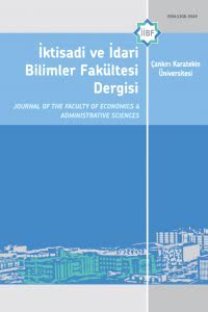PROBİT MODEL YAKLAŞIMI İLE KAYIT DIŞI İSTİHDAMI ETKİLEYEN FAKTÖRLERİN BELİRLENMESİ
Hanehalkı İşgücü Anketi, Probit Model, TÜİK, Marjinal Etkiler
Empirical Reflections of the Nexus between Dual Banking System Credits and Industry Production in Turkey: Cointegration and Causality Analysis
Islamic Banks, Conventional Banks, Industry Production, , Cointegration, Causality,
___
- Agresti, A. (2002). Categorical data analysis John Wiley & sons. Inc., Publication, 15, 24.
- Alptekin, E. (2007). Türkiye’nin Bitmeyen Derdi Kayıt Dışı, Ar & Ge Bülten.
- Bairagya, I. (2012). Employment in India’s informal sector: size, patterns, growth and determinants, Journal of the Asia Pacific Economy, 17(4), 593-615.
- Başlevent, C. ve Acar, A. (2015). Recent Trends in Informal Employment in Turkey, Yildiz Social Science Review, 1(1), 77-88.
- Dünya Bankası. (2010). Türkiye Ülke Ekonomik Raporu, Kayıt dışılık: Nedenler, Sonuçlar, Politikalar, Rapor No: 48523-TR.
- Fidan, H. ve Genç, S. (2014). Kayıt dışı İstihdam ve Kayıt dışı İstihdama Etki Eden Mikro Faktörlerin Analizi: Türkiye Özel Sektör Örneği, Mehmet Akif Ersoy Üniversitesi Sosyal Bilimler Enstitüsü Dergisi, 5(9), 137-150.
- Gallaway, J. ve Bernasek, A. (2002). Gender and Informal Sector Employment in Indonesia, Journal of Economic Issues, 36(2), 313-321.
- Gërxhani, K. (1999). The Informal Sector in Developed and Less Developed Countries, Tinbergen Institute Discussion Paper, No: TI-083/2.
- Gkritza, K. (2009). Modeling motorcycle helmet use in Iowa: evidence from six roadside observational surveys. Accident Analysis & Prevention, 41(3), 479-484.
- Greene, W. H. (2002). Econometric Analysis, New Jersey: Prentice Hall.
- Gujarati, D. ve Porter, D. (2012). Temel Ekonometri (Translated By Ümit Şenesen and Gülay Günlük Şenesen), İstanbul: İstanbul Literatür Yayınları.
- Güloğlu, T., Korkmaz, A. ve Kip , M. (2003). Türkiye'de Kayitdişi İstihdam Gerçeğine Bir Bakiş, Sosyal Siyaset Konferansları Dergisi, (45), 51-96.
- Güriş, S. ve Astar, M. (2015), SPSS İle İstatistik, İstanbul: DR Yayınları.
- Kalaycı, C. ve Kalan, E. (2017). Türkiye’de Kayıt Dışı İstihdamla Mücadele Politikalarının Analizi/The Analysis Of Policies To Fight Against Informal Employment In Turkey. Uluslararası Ekonomi İşletme Ve Politika Dergisi, 1(1), 17-34.
- Larsen, C., Rand, S., Schmid, A., Bobkov, V. Ve Lokosov, V. (2019). Assessing Informal Employment and Skills Needs: Approaches and Insights from Regional and Local Labour Market Monitoring, München.
- Long, J. S. ve Freese, J. (2000). Scalar measures of fit for regression models. Stata Technical Bulletin, 56, 34-40.
- Merkuryeva, I. (2006). The structure and determinants of informal employment in Russia: Evidence from NOBUS data. Discussion Paper. Saint-Petersburg Stata University Institute of Management.
- Oktar, K. (2004). Kayıt dışı İstihdam ve Sosyal Güvenlik, TBB Dergisi, 53, 266-270.
- Öztürk, S. ve Başar, D. (2018). Türkiye’de Kadınların İşgücü Piyasasına Yönelik Tercihleri: Kayıt Dışı Sektör Özelinde Bir Analiz, SGD-Sosyal Güvenlik Dergisi, 8(2), 41-58.
- Sas, Computing Marginal Effects for Discrete Dependent Variable Models. https://support.sas.com/rnd/app/ets/examples/margeff/index.html (Erişim Tarihi: 20 Mart 2021)
- Ucla. (2016). Statistical Consulting Group. Probit Regression/ Stata Data Analysis Examples, https:/stats.idre.ucla.edu/stata/dae/probit-regression/ (Erişim Tarihi: 10 Mart 2021)
- Veall, M. ve Zimmerman, K. (1994). Evaluating Pseudo-R2's for binary probit models, Quality and Quantity, 28(2), 151-164.
- Wamuthenya, W. (2010). Determinants of employment in the formal and informal sectors of the urban areas of Kenya, Kenya: Modern Lithographic (K) Ltd.
- Zellner, A. ve Lee, T. (1965). Joint estimation of relationships involving discrete random variables, Econometrica: Journal of the Econometric Society, 382-394.
- ISSN: 1308-5549
- Yayın Aralığı: 4
- Başlangıç: 2011
- Yayıncı: Çankırı Karatekin Üniversitesi
Beta Risklerinin Modellenmesi ve Tahmini: Türkiye’deki Döviz Portföyü Örneği
Serdar NESLİHANOĞLU, Merve PAKER
INCOTERMS 2000, 2010 ve 2020 REVİZYONLARINA GENEL BAKIŞ
Probit Model Yaklaşımı ile Kayıt Dışı İstihdamı Etkileyen Faktörlerin Belirlenmesi
Zübeyde ÇİÇEK, Nuran BAYRAM ARLI
Çalışanların Rekabetçi Tutumu: Benlik Saygısı ve Kontrol Odağının Açıklayıcı Rolü
Tüketicilerin Organik Gıdaları Satın Alma Niyetine Etki Eden Faktörlerin İncelenmesi
Nur ÇAĞLAR ÇETİNKAYA, Tülin DURUKAN, Serhat KARAOGLAN
DESTİNASYON İMAJI VE ZİYARETÇİ MEMNUNİYETİNİN DESTİNASYON AİDİYETİ ÜZERİNE ETKİSİ
Mustafa Taylan DAĞISTAN, İrfan MISIRLI
KARANLIK HAVUZLAR UYGULAMASININ BORSA İSTANBUL ÜZERİNE ETKİSİ : KALMAN FİLTRE YAKLAŞIMI
